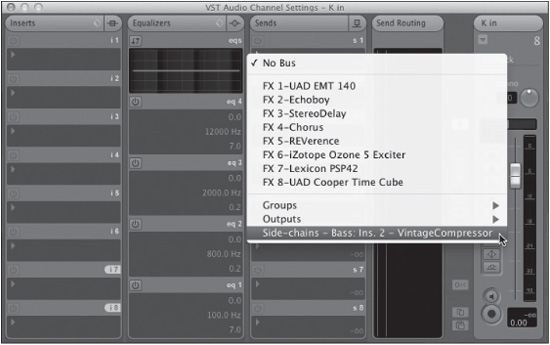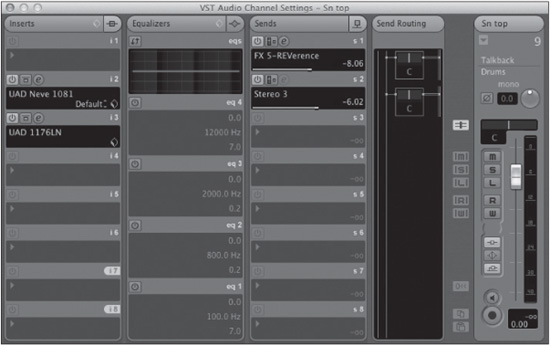Aux Sends
Aux sends aren’t just for reverb anymore. One of the common misconceptions about auxiliary sends is that they are somehow inferior to the Main Mix bus or other paths in the mixer. This may have been true with analog consoles that had to make concessions in order to balance costs of manufacturing, but this is not true of the Nuendo mixer.
Each auxiliary send has the same bandwidth, signal-to-noise ratio, and other characteristics of the Main Mix bus. In fact, every signal path within Nuendo’s mixer is the same with regards to fidelity and sound quality.
With this in mind, aux sends can be used for many other tasks besides sending signals to FX processors, such as reverb and delay plug-ins. In this example, a second drum group is set up for parallel compression. This technique, popularized as New York parallel drum compression, is used for many things besides drums.
Parallel Bus Compression
In order to set up the parallel drum compression technique, go to the drum group channel and create an aux send routed to the Drum Comp group. Set this aux send to pre-fader and the gain to unity (0 dB).
On the Drum Comp group, insert your favorite drum compressor and adjust for a fairly aggressive compression to start with. Pull the fader all the way down and start playback. Slowly turn up the compressed signal to hear how it affects the drum sound. (See Figure 16.15.)
Figure 16.15 Parallel compression setup.

Nuendo’s plug-in delay compensation engine will adjust for the plug-in latency caused by the compressor and routing so that both signals will be in perfect phase. They can be mixed together without fear of comb filtering caused by delays between the two signals.
Normal FX Sends
Of course, the aux sends can be used to route signals to the various effects channels created earlier in this example. You could feed the lead vocal into the plate reverb, short delay, and perhaps the stereo slap delay. These might be static levels that remain through the entire song.
The long echo might be an effect that only happens at certain times in the arrangement. You can still use an aux send and then automate its level to send signal to the long delay at only those times. (See Figure 16.16.)
Figure 16.16 Lead vocal aux sends.

FX Send to FX
It is possible to route aux send from one FX channel to another. For example, the long echo could be routed to the plate reverb for a deeper sound. The routing is extremely flexible in Nuendo so that ideas are not hindered by technical limitations. Almost every channel in the mixer can be routed in one way or another to every other channel. (See Figure 16.17.)
Figure 16.17 Echo send to plate.
Caution The one type of signal path that is not allowed in Nuendo, is any path that causes an internal feedback loop. For example, you cannot route an aux send from a group channel back to the input of that group channel, creating a feedback loop. The only way to create a feedback loop in Nuendo is to patch an output of the audio interface back into an input and route that to create a feedback situation. This will necessarily have some amount of delay resulting from the AD–DA conversion.
Secondary Aux Paths
In addition to all these seemingly normal uses for aux send paths, there are others that are not so obvious. For example, let’s say that the snare sounds very good, but you want it to have more level and punch in the mix.
Since we have a drum bus compressor setup in the summing box (the 33609) that is compressing the entire mix of drums, turning up the snare will cause the compressor to clamp down further on all the other drums. This might not be a good thing since the rest of the drums are sounding just right.
The solution is to use an aux send to route the snare to an uncompressed channel on the summing box. Stereo 3 does not have any compression on it and will work for this technique. (See Figure 16.18.)
Figure 16.18 Snare aux to Stereo 3.
Route an aux send from the snare top channel to Stereo 3 and adjust the level to increase the punch of the snare without pumping the drum bus compressor any more. This will feel and sound like an effortless increase in the snare in the mix without any drastic alteration of the dynamics of the rest of the instruments.
Side-Chain Signals
Since VST 3-compatible plug-ins offer a side-chain signal path, many classic techniques from the analog recording days have become possible in Nuendo. Side-chains may be used to duck signals, trigger gates, etc. Aux sends are a great way to route signals to side-chain inputs of plug-ins.
When a compatible plug-in is inserted and the side-chain activated, the side-chain input becomes a destination for aux sends and channel outputs. Let’s say you want to compress the bass with the kick drum to tie the two together for more cohesion:
1. Insert the Vintage Compressor plug-in on the Bass group channel so the kick will compress the entire bass sound, amp, and DI.
2. Enable the side-chain input on the plug-in. (See Figure 16.19.)
Figure 16.19 Vintage Compressor plug-in with side-chain activated.
3. Create an aux send on the Kick In channel that is routed to the Vintage Compressor’s side-chain input. (See Figure 16.20.)
Figure 16.20 Aux send routed to the side-chain input.

4. Play back the drums and bass and adjust the aux send level and compressor controls so that when the kick drum hits, you see some amount of compression happening in the plug-in.
5. Blend the drums and bass together for the desired effect.



